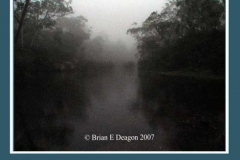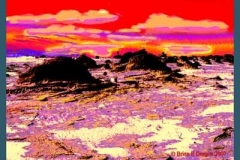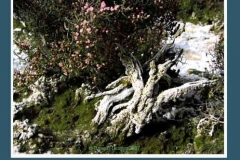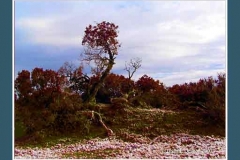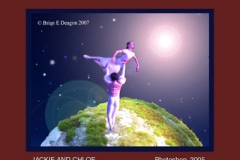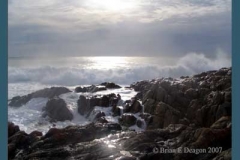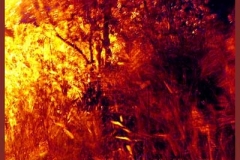After a trip to Cairns I began painting rainforest as well as swamp. The relentless green was a problem, and after painting “Swamp” in muted earths I could see a way forward.
Category Archives: Blog
Hi Deevya
We have several issues here. Malevitch first. You have to understand that a lot of C20 art was painted as illustrations to a philosophical argument. Those arguments often used a reductionist logic as science did at the time. Scientists and mathematicians were looking for a single simple equation that would explain the universe. They are still looking.
In art , the question became “ how little can you have and still have an art work?” A black square? A white one? No paint at all- just bare canvas? How about an empty frame?
Now this is a fun game to play, and you don’t need a traditional skill set to play it. My problem with it is that it doesn’t make very interesting pictures.
So how about we go the other way and try to make fun paintings. No matter what you do, to be visible you need line,colour,tone,texture, shape and etcetera. I THINK that’s what you mean by “form”. Instead of the elements above some just talk about “form” and “space”. Now, a beautiful rock or shell or seedpod is visible form in space. We just enjoy them. Humans always have. But something funny happens when an artist makes a beautiful form in space. Instead of “That’s nice, I will hang it around my neck or put it on the table to look at” we start asking stupid questions like “What does it mean?” “ Whats it supposed to be?” “ Where has it come from?”” Why am I attracted to it?” “How is it made?”
Frequently these dumb questions get really out of hand, and result in coffee table books of art criticism. I learned my lesson from John Marwundjul. I asked him” How do you know where to put things?” I suppose I was expecting deep insights into his culture.I got one!His reply said it all. With a big wide smile at my ignorance he said “Look nice” I never felt so stupid in all my life. That’s it? “Look nice?” Yep. Look nice!
Brian E Deagon
Friday March 16th, 2012 11:16 am
Related Images:
Abstraction in Art
“There are no rules. No guidelines. No boundaries .” my friend complained. “How do you do abstract art ?” he wondered.
Thinking about it, I could see he had a genuine concern. I had no answer other than to mutter “ Mysticism. Its about esoteric mystical concepts of purification. Its shamanic identification with the creative process.”
He frowned. Clearly that was not helpful.
Perhaps we could consider its parentage in Cubism and Surrealism?
Cubism itself had its lineage, including ( in no particular order)
- Cezanne’s difficulties understanding binocular vision, resulting in multiple viewpoints.
- New style shop windows which allowed the artist to see not only the window contents but also the reflected artist and the street behind him.
- Double exposures and X-ray photography
- Einsteins Theories on space and time
- Bargue’s guidelines for figure drawing
- The “discovery” of indigenous art, which was ( no..still is )viewed romantically as somehow more “pure” or “elemental”. It was used as a kind of purgative to remove layers of sclerotic culture and offered a new beginning. The new beginning became a nightmare in WW1
The outcomes of this torrent we are all familiar with. The upshot was a structure of mostly straight lines creating interpenetrating planes and a kind of elliptical composition. These planes do not exist behind the picture plane, but on it, or even project illusionistically into the viewers space, while still remaing parallel to the picture plane.
Understanding this structure is important, for it provides the underpinning of abstraction, the dominant “look” of the style. The Bauhaus reinforced this, taking over architecture, typeface, furniture. Its everywhere.
Surrealism had two arms, both belonging to Madame Blavatsky.
One was dependent on traditional illusionistic painting. Only the subject matter was bizarre. Burning giraffes come to mind.This flourishes in film still.
Of more importance was a more extreme outpouring of Freud and Jung’s unconscious that utilised chance or surrender of control as a creative principle. Hence the throwing and splashing, the random ravages of weather or processes such as burning or collaged images from every fifth page.
When American artists in the aftermath of WW2 and the Korean war discovered calligraphy it blended seamlessly with this style of Surrealism.
The preparation of the artist before gesturing meaningfully upon a canvas was central to the creative process . Very Zen. Lots of positive and negative space.This is the shamanic side of abstraction. This led to extremes which in turn literally killed artists. Drug addiction is a poor preparation it seems.Better to meditate upon Earth Air Fire and Water, or play the Sex Pistols VERY loud.
So there is the Yin and Yang of it. On the one hand the artist manipulates mediums to create a structure that is an expression of the artists will, and the cubist ghost is never far away: and on the other the artist becomes part of the medium which creates by itself a structure that is revealed in the making, and is independent of the artist’s will. Surreal really.
In actual practice, most artists waver between these extremes. Kandinsky encompassed both. Most of the abstract “isms” live or die here.
Wolesy will bury his drawings for six months, Klien will cover his models in paint and roll them across a canvas, Gleeson will let paint run and blend , then use the result as a trigger for his quite beautiful brush. Mondrian and other purists were messionic about minimal means. Kline ,Motherwell and the Europeans Matthieu, Sonderborg took gestural calligraphy to extremes, but never matched the Chinese. Pollock poured out his soul, but who knows where it went?
Vestigial colours of landscape, a horizon here or there, a hint of a figure and some will cry “ Its not abstraction!” But does it really matter?
In the zeal some posess to “restore the old ways of the masters” we had better be careful. It’s a coaches nightmare to have his team obsessing about what the opposition is doing. Rather than pointless spleen levelled at Modern Art and its advocates, it makes more sense to remember that the work that was produced belonged to a particular historical period. Even if we don’t like the art, we should have the sense to view it with the eye of the anthropological archaeologist. “ What does this thing mean?” is a question never fully answered. And we might learn something after all.
Brian Deagon
6/02/2012
Related Images:
The Art of Australia
When I called my website “the Art of Australia” it was in anticipation of a stay in America. It was only in considering what to include in a retrospective exhibition that I realised that I had landscapes representing every State in Australia except South Ausralia.
Its enough to have me planning another road trip!
Related Images:
Tom Roberts as History Painter
Tom Roberts painting “Bailed Up” is a history painting in the same tradition as Velasquez “Surrender at Breda” or Gericault’s “Raft of the Medusa”.
He worked on the thing over 30 years. Part dramatic reenactment, part reportage, part documentary, but in the long run a homage to a time in history that had passed before he even began the work, Roberts clearly intended this painting to be his legacy.
What is less clear is what Roberts own criteria for success were. He was well read, widely travelled in Europe, so would have been aware that History painting was considered the most difficult and important genre. If we apply those criteria applied to other history painting, we will begin to see both the artist and his work in a new light.
Definitely more than an “impressionist” plein air piece, it is a studio picture in most ways Preliminary sketches, portraits of characters, accurate details of accessories such as guns, costumes and coach all point to the long gestation of the painting. Even the landscape painted largely on the spot was reworked later. It would take the eye of a horseman to recognize the breeds portayed, the harness details and coach fittings. Roberts was, and aware of the critical rural eye that would notice such things
If histories can be rewritten, and new perspectives revealed by focus on different incidents and artefacts, then surely the “history painting” itself can be repainted.? Most history painting was in the “great men doing great deeds” view of history. Courbet and Manet challenged that. There are other histories to be had.”Bailed Up” may be an “icon”, but is it the last word?
It seems to me that the “assemblage” approach, the gathering of site specific soil samples and referencing almost random photos, plants and geological maps, fabric samples etc is not the only way of deep referencing. A pictorial approach to the narrative (and these days ya gotta have a “story” underpinning the “project”) may still be possible without the result being “only” or “just….. History painting.”
Related Images:
Rhetoric and Hadyn
Sir Kenneth Clark posits that the Classic nude is aesthetically and culturally beyond us. The completeness of rhetoric and technique are averse to our prediliction for the fragmentary and accidental. This came up again with Prof Lancaster and Hadyn. He points out that Baroque musical form is based upon the rhetorical devices of Quintillian. One states a premise,and another,then develops an argument and arrives at a conclusion. The “premise” is stated as a musical theme or idea.I assume, the same would have been applied to painting and all the other arts, particularly given the multi-arts sweep of Baroque. The wit, Professor Lancaster says, has an “aha “quality, not a “ha ha”. A large part of this would have been the conspicuous displays of erudition,linking subthemes and motifs,legends and narratives, as a commentary on the main theme or subject. Of more interest to me,is the notion that the pictorial language of pure composition must have been considered in the same way.Note that “rhetoric” here is more than “allegory” and “technique” means more than”finish”. Thats where it ended up in the worst of Salon Silliness.In Renoir’s Grand Baignuese we can see an impressionist realising that the dissolution of form itself had to be resisted in the nude, but is happily accommodated by the landscape.Renoirs painting is an argument as rhetorical as can be.
Related Images:
Acclamation
Why is it that a violinist can play Mozart , an actor breathes life into Shakespeare, a dancer dies as a swan yet again memorably, and all these artists receive acclaim, but if a visual artist declares ” I will now “do Rubens”, a completely different set of assumptions apply.?
I contend it is the assumptions that are misguided, and completely miss the point. If Rubens(or any other master) is my composer, my playwright,my choreographer, then judge my performance accordingly,starting with whether I know the script.
After all, if your role is to provide illustrations to,and demonstrations of, the theories and pronouncements of art critics and impenetrable French philosophers; so should your work be judged-as just that.
Related Images:
On the use of photographs
There is so much nonsense about the use of photographs, but most important is the issue of copying them. Why not use a photocopier and be done with it?
The truth is, that the camera ALWAYS lies! Shadow and light remove colour from objects,lenses distort,even the inks used in printing are only approximations. Because this is so, you must interpret,interpolate,simplify:all manner of things. The aim is not to copy the photo, but to create an illusion. Behind the illusion lies the artists knowledge or lack of it, and that is revealed as brutally as in drawing from life.
In fact, the well constructed life drawing reveals more than the photograph ever can, because the artist sees “through” the accidents of light. It is a question of the “long look” over time, which is demanded of the viewer of the drawing as well as the artist. The focus keeps moving, so that “depth of field” is constructed from myriad perspectives, not the single, fixed,lens-bound monocular vision of the camera. A similar argument appies to colour perception, where the artist reacts to after-images and simultaneous contrasts in different time contexts.
This is not to deny that the camera “sees” things we cannot normally see. It just means the camera extends our potential range of vision and subject.
Related Images:
On “Progress”
Richard Wright uses the image ” on the ladder of progress,kicking out the the rungs below us “.If this is Jacobs Ladder, what if we get to the top to discover we are not in heaven? And I use the “snakes and ladders” game to indicate that the ladder has as many unintended consequences as intended, and( commonsense with a vertical and horizontal axis resulting in four quadrants beloved of seminar presenters) some of these pleasant as well as unpleasant.. Now there’s a conceptual frame to interrogate a discourse,with. Hmm.
Related Images:
There’s no going back, But I’m going
Theres no point in silverpoint now I have a pencil, no point in lapis lazuli now I have ultramarine, no point in egg emulsion now I have acrylic and oil. But to use all of the old materials and techniques is an education in how to use the modern equivalent. I now know, because I have been there.
In “Image of the Body” Michael Gill makes the observation that the same desire to record every detail produced double entry bookkeeping accounts and Florentine art. It makes sense that the patrons of the C15 should bring the same attitudes to Art as they did to business.
And I have mused about the cultures that tend to Realism before. The Dutch invented the stock market and exported it to Boston and New York. Academic Realism that Americans preserve from C19 English Empire and C19 French, has the same love of detailed “finish”. They bring the same aesthetic to the nude as they do to chrome automobiles.
This weakness is to be avoided. That does not mean that the whole style is to be avoided.For me, the brushmark must finally be triumphant, and that is why Rubens is a touchstone
